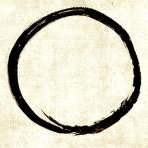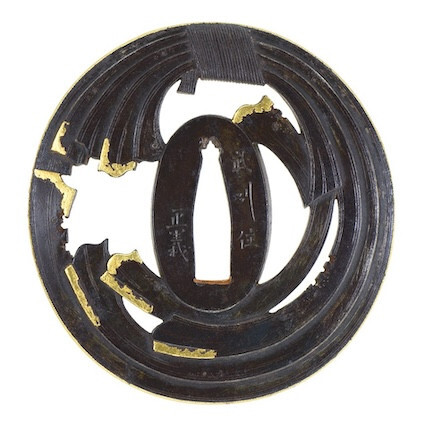-
Posts
380 -
Joined
-
Last visited
-
Days Won
1
Content Type
Profiles
Forums
Events
Store
Downloads
Gallery
Everything posted by FlorianB
-
Never saw this before. It looks like a modern amateurs work. Do I see correctly the front is flat and the back hollowed? Best, Florian
-
It was purchased in 1911, but this means not necessarily it was made at this point. However, the idea is intriguing, cubism combines different views on a motiv and thus plays with different shapes (triangels, too). But what is the motif here? I agree with Jean C. it is at least a collection of pattern maybe to present different possibilities how to decorate a surface. It reminds me to patterns seen on habaki. Perhaps it would be an idea to post it into Bruce’s thread: www.militaria.co.za/nmb/topic/32583-cat-scratch-habaki/ . Best, Florian
-
The discus shape (naka-daka) is typical for Edo Tsuba. On pre-Edo Tsuba frequently naka-kubo (rim thicker than seppa-dai) is to be seen. Tsuba with uniform thickness have been made through all ages and thus difficult to determine by shape alone. BTW: The fan shape (as I called it) is also described as inome (boars eye) or suhama (beach) by others. Don't know what's right. Best, Florian
-
Hello Henry, it would be helpful giving the dimensions of the Tsuba - height, width and thickness both at the rim and the seppa-dai. Some more pictures in different angles would be useful, too. My first impression was Edo-period (Genroku or later) and I agree with Jeremys and Brians explanations. The design with its clever combination of blossom and fan-shape (?) hints to a later interpretation of the Tosho-style. If it looks older in Your eyes it’s just because of a corroded surface resulting of careless treatment in the past. Nevertheless it would be worth recovering the patination. Best, Florian
-
Hi Robert, I was tempted to buy it for myself but after long consideration (at least too long) suddenly it vanished. So You got it, congrats! It’s a classical beauty and well done! Best, Florian
-
It’s the result of overestimation of papers. Today it seems every piece must have a certificate. In my eyes the necessity of those is in question anyway not to mention discussions about the outcome. The collectors should learn again to estimate the significance by own examination and in discussion with other collectors instead sticking to a paper. Best, Florian
-
Example for drawer handles on a traditional tansu (seen on https://www.van-ham.com/de/kuenstler/1/zweiteiliges-isho-kasane-dansu.html):
-
Hi Steve, I think the forms to the right and left are drawer handles plus rings, at the top and bottom maybe warabite (fern sprouts) facing each other. Best, Florian
-
It’s definitely the above shown music instrument. The misinterpretation may be caused by the adaption to the circle. Noshi strips are arranged more freely like this: (world.seiyudo.com/product/tu-010517/) Best, Florian
-
Hi, I found this picture in my photo collection: I think I've copied it from Aoi Art in January. The description says: Kyo Sukashi, 8.25cm x 8.50 cm x 0.53cm, Edo period, 67g There must be a Hozon paper for this piece, but I haven't copied it. Best, Florian
-
The nunome was a point that speaks against a chinese fake. So I was too hasty in my judgement. But I don’t know what to make out of this piece, it looks suspicious in my eyes and there are too many questionable details. Best, Florian
-
The alteration of the nakago ana is most unusual, never seen this before. Customarily a flattening is made on both sides by hammering, here it looks like carved out. I can’t see any sense for this. I stick to my impression that this piece was made in some Chinese workshop. The silence of the other board members tells it own tale. However, take it as it is and if You enjoy it - it’s all right. Next time maybe a better catch! Best, Florian
-
Hi George, sorry to be frank, but the carving seems a little bit crudely done. The modification around the nakago ana looks artificial to feign often usage. At least I’m not sure if it is Japanese at all. I hope, it wasn’t too expensive. Best, Florian
-
Looks like the simplified upper end of a curtain to me, so I can imagine there’s a curtain behind the tree or the tree itself is as a pattern on the curtain. Not sure about the right term - noren or jinmaku. Best, Florian
-
Yes, I know it seems to be a fishy creature, but somehow it reminded me also to a wild boar. Like these: (Seen on https://nihontofranc...inko-menuki/?lang=en (sold item)) Obviously a cross between different animals surrounded by lucky charms. Haven't seen this before! Best, Florian
-
In Edo period books with collections of kamon were published and those were a source of inspiration for the Tsuba makers. It is possible, that indiviuals purchased such a Tsuba because it shows the personal mon. But I dare to doubt that was the intention of the tsubako. At least everyone could buy and wear these. There are formal sword fittings which have the function to show the kamon and thus the family representing, but these were Kinko works. Daimyo and Samurai wore them on special occasions. BTW: It seems to be an interesting question at which point a motif could be called kamon. The lobster Tsuba for instance show IMHO no kamon - sometimes lobsters are just lobsters… Best, Florian
-
Obviously pines - short stems at the axes, tufts of needles arranged circular. No relationship to the imperial family ! Florian
-
Yes, there are kamon associated with the imperial family. And yes, there are reams of tsuba in numerous kikugata shapes available for all who wanted one. Tsubako were inspired by forms, created fashion, copied other works - at least to sell their products. That’s why so different styles and qualities were produced. The chrysantemum shape is first of all just no more than a common decoration on the rim of Tsuba. So in my eyes it is very speculative to connect the kikugata with the emperor and his relatives. Wearing a crown I become not a member of the royal family (not even Freddy Mercury)! Best, Florian
-
Hi, another one for comparision (or addition ): https://tsubashi.com...-water-nobuie-tsuba/ Best, Florian
-
"There are more things in heaven and earth, Horatio, than are dreamt of in your philosophy" - Hamlet Best, Florian
-

Submitting Tsuba for Grading and Papers - Thoughts?
FlorianB replied to Winchester's topic in Tosogu
The problem is the lack of any explanation for an attribution. Frequently a temporal classification is omitted, too. Even the quality of a tsuba can’t be recognized because there are high class Tsuba and low end specimen with Hozon. But sometimes the description of the motif is informative, in some cases, however, cryptic. Best, Florian -
It is difficult to determine the age. There are specimen about the same thickness which date back to be Muromachi-period, so I think Richard is right. However it is worth to recover the beauty by removing the rust and careful rubbing. BTW on Paul’s Tsuba.info is also an example with karigane in a cartouche: https://tsuba.info/tosho/ Best, Florian
-
Hello Mario, definitive not (Ko-)Katchushi. This kind of Saotome/Tembo-style Tsuba was made from late Muromachi till the late Edo-period. Unfortunately the surface is very corroded so it seems difficult to make a statement concerning the age. Best, Florian
-
Hello Mario, my first impression seeing Your Tsuba was Shoami - because I remembered a similar one in Sasano’s book: He sticks it into Momoyama period, in my eyes Yours is a later specimen because of the broad rim. Best, Florian
-
The Suketaka signature looks indeed a little bit amateurish, there are better examples. However, the hamon - as far as to recognize - displays Suketaka’s toran-ba comprising a wavy pattern with two tama above. The motif of the Kozuka shows a famous Zen koan of someone who tries to catch a catfish with a gourd. The back side shows interesting ornamental strips, maybe to refer to the water theme on the front. Note the fine nanako surface in comparision to the coarser one on the dragon Kozuka. The dragon itself looks not done well either (sorry to be frank). The chinese sages kozuka seems to consist of iron with nikubori and inlays of different metals. This technique appears frequently. Not the best quality but neatly done. Best, Florian









